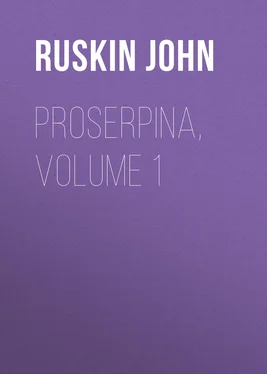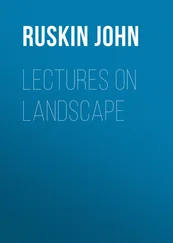John Ruskin - Proserpina, Volume 1
Здесь есть возможность читать онлайн «John Ruskin - Proserpina, Volume 1» — ознакомительный отрывок электронной книги совершенно бесплатно, а после прочтения отрывка купить полную версию. В некоторых случаях можно слушать аудио, скачать через торрент в формате fb2 и присутствует краткое содержание. Жанр: foreign_antique, Биология, literature_19, foreign_edu, на английском языке. Описание произведения, (предисловие) а так же отзывы посетителей доступны на портале библиотеки ЛибКат.
- Название:Proserpina, Volume 1
- Автор:
- Жанр:
- Год:неизвестен
- ISBN:нет данных
- Рейтинг книги:3 / 5. Голосов: 1
-
Избранное:Добавить в избранное
- Отзывы:
-
Ваша оценка:
- 60
- 1
- 2
- 3
- 4
- 5
Proserpina, Volume 1: краткое содержание, описание и аннотация
Предлагаем к чтению аннотацию, описание, краткое содержание или предисловие (зависит от того, что написал сам автор книги «Proserpina, Volume 1»). Если вы не нашли необходимую информацию о книге — напишите в комментариях, мы постараемся отыскать её.
Proserpina, Volume 1 — читать онлайн ознакомительный отрывок
Ниже представлен текст книги, разбитый по страницам. Система сохранения места последней прочитанной страницы, позволяет с удобством читать онлайн бесплатно книгу «Proserpina, Volume 1», без необходимости каждый раз заново искать на чём Вы остановились. Поставьте закладку, и сможете в любой момент перейти на страницу, на которой закончили чтение.
Интервал:
Закладка:
On these guarded conditions, then, I proceed to study, with my reader, the first general laws of vegetable form.
CHAPTER II.
THE ROOT
1. Plants in their perfect form consist of four principal parts,—the Root, Stem, Leaf, and Flower. It is true that the stem and flower are parts, or remnants, or altered states, of the leaves; and that, speaking with close accuracy, we might say, a perfect plant consists of leaf and root. But the division into these four parts is best for practical purposes, and it will be desirable to note a few general facts about each, before endeavouring to describe any one kind of plant. Only, because the character of the stem depends on the nature of the leaf and flower, we must put it last in order of examination; and trace the development of the plant first in root and leaf; then in the flower and its fruit; and lastly in the stem.
2. First, then, the Root.
Every plant is divided, as I just said, in the main, into two parts, and these have opposite natures. One part seeks the light; the other hates it. One part feeds on the air; the other on the dust.
The part that loves the light is called the Leaf. It is an old Saxon word; I cannot get at its origin. The part that hates the light is called the Root.
In Greek, ῥίζα, Rhiza. 13 13 Learn this word, at any rate; and if you know any Greek, learn also this group of words: "ὡς ῥίζα ἐν γῆ διψωσῃ," which you may chance to meet with, and even to think about, some day.
In Latin, Radix, "the growing thing," which shortens, in French, into Race, and then they put on the diminutive 'ine,' and get their two words, Race, and Racine, of which we keep Race for animals, and use for vegetables a word of our own Saxon (and Dutch) dialect,—'root'; (connected with Rood—an image of wood; whence at last the Holy Rood, or Tree).
3. The Root has three great functions:
1st. To hold the plant in its place.
2nd. To nourish it with earth.
3rd. To receive vital power for it from the earth.
With this last office is in some degree,—and especially in certain plants,—connected, that of reproduction.
But in all plants the root has these three essential functions.
First, I said, to hold the Plant in its place. The Root is its Fetter.
You think it, perhaps, a matter of course that a plant is not to be a crawling thing? It is not a matter of course at all. A vegetable might be just what it is now, as compared with an animal;—might live on earth and water instead of on meat,—might be as senseless in life, as calm in death, and in all its parts and apparent structure unchanged; and yet be a crawling thing. It is quite as easy to conceive plants moving about like lizards, putting forward first one root and then another, as it is to think of them fastened to their place. It might have been well for them, one would have thought, to have the power of going down to the streams to drink, in time of drought;—of migrating in winter with grim march from north to south of Dunsinane Hill side. But that is not their appointed Fate. They are—at least all the noblest of them, rooted to their spot. Their honour and use is in giving immoveable shelter,—in remaining landmarks, or lovemarks, when all else is changed:
"The cedars wave on Lebanon,
But Judah's statelier maids are gone."
4. Its root is thus a form of fate to the tree. It condemns, or indulges it, in its place. These semi-living creatures, come what may, shall abide, happy, or tormented. No doubt concerning "the position in which Providence has placed them " is to trouble their minds, except so far as they can mend it by seeking light, or shrinking from wind, or grasping at support, within certain limits. In the thoughts of men they have thus become twofold images,—on the one side, of spirits restrained and half destroyed, whence the fables of transformation into trees; on the other, of spirits patient and continuing, having root in themselves and in good ground, capable of all persistent effort and vital stability, both in themselves, and for the human States they form.
5. In this function of holding fast, roots have a power of grasp quite different from that of branches. It is not a grasp, or clutch by contraction, as that of a bird's claw, or of the small branches we call 'tendrils' in climbing plants. It is a dead, clumsy, but inevitable grasp, by swelling, after contortion. For there is this main difference between a branch and root, that a branch cannot grow vividly but in certain directions and relations to its neighbour branches; but a root can grow wherever there is earth, and can turn in any direction to avoid an obstacle. 14 14 "Duhamel, botanist of the last century, tells us that, wishing to preserve a field of good land from the roots of an avenue of elms which were exhausting it, he cut a ditch between the field and avenue to intercept the roots. But he saw with surprise those of the roots which had not been cut, go down behind the slope of the ditch to keep out of the light, go under the ditch, and into the field again." And the Swiss naturalist Bonnet said wittily, apropos of a wonder of this sort, "that sometimes it was difficult to distinguish a cat from a rosebush."
6. In thus contriving access for itself where it chooses, a root contorts itself into more serpent-like writhing than branches can; and when it has once coiled partly round a rock, or stone, it grasps it tight, necessarily, merely by swelling. Now a root has force enough sometimes to split rocks, but not to crush them; so it is compelled to grasp by flattening as it thickens; and, as it must have room somewhere, it alters its own shape as if it were made of dough, and holds the rock, not in a claw, but in a wooden cast or mould, adhering to its surface. And thus it not only finds its anchorage in the rock, but binds the rocks of its anchorage with a constrictor cable.
7. Hence—and this is a most important secondary function—roots bind together the ragged edges of rocks as a hem does the torn edge of a dress: they literally stitch the stones together; so that, while it is always dangerous to pass under a treeless edge of overhanging crag, as soon as it has become beautiful with trees, it is safe also. The rending power of roots on rocks has been greatly overrated. Capillary attraction in a willow wand will indeed split granite, and swelling roots sometimes heave considerable masses aside, but on the whole, roots, small and great, bind, and do not rend. 15 15 As the first great office of the mosses is the gathering of earth, so that of the grasses is the binding of it. Theirs the Enchanter's toil, not in vain,—making ropes out of sea-sand.
The surfaces of mountains are dissolved and disordered, by rain, and frost, and chemical decomposition, into mere heaps of loose stones on their desolate summits; but, where the forests grow, soil accumulates and disintegration ceases. And by cutting down forests on great mountain slopes, not only is the climate destroyed, but the danger of superficial landslip fearfully increased.
8. The second function of roots is to gather for the plant the nourishment it needs from the ground. This is partly water, mixed with some kinds of air (ammonia, etc.,) but the plant can get both water and ammonia from the atmosphere; and, I believe, for the most part does so; though, when it cannot get water from the air, it will gladly drink by its roots. But the things it cannot receive from the air at all are certain earthy salts, essential to it (as iron is essential in our own blood), and of which when it has quite exhausted the earth, no more such plants can grow in that ground. On this subject you will find enough in any modern treatise on agriculture; all that I want you to note here is that this feeding function of the root is of a very delicate and discriminating kind, needing much searching and mining among the dust, to find what it wants. If it only wanted water, it could get most of that by spreading in mere soft senseless limbs, like sponge, as far, and as far down, as it could—but to get the salt out of the earth it has to sift all the earth, and taste and touch every grain of it that it can, with fine fibres. And therefore a root is not at all a merely passive sponge or absorbing thing, but an infinitely subtle tongue, or tasting and eating thing. That is why it is always so fibrous and divided and entangled in the clinging earth.
Читать дальшеИнтервал:
Закладка:
Похожие книги на «Proserpina, Volume 1»
Представляем Вашему вниманию похожие книги на «Proserpina, Volume 1» списком для выбора. Мы отобрали схожую по названию и смыслу литературу в надежде предоставить читателям больше вариантов отыскать новые, интересные, ещё непрочитанные произведения.
Обсуждение, отзывы о книге «Proserpina, Volume 1» и просто собственные мнения читателей. Оставьте ваши комментарии, напишите, что Вы думаете о произведении, его смысле или главных героях. Укажите что конкретно понравилось, а что нет, и почему Вы так считаете.












